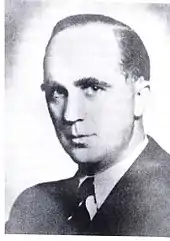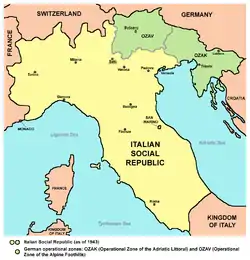Rudolf Rahn
Rudolf Rahn (16 March 1900 – 7 January 1975) was a German diplomat who served the Weimar Republic and Nazi Germany. As a member of the Party, and as Plenipotentiary to the Italian Social Republic in the closing stages of the Second World War, he was arrested and held at Nuremberg as a potential war criminal, but he was released in 1949 and deemed to be denazified in Class V (exonerated).

Early life
Born at Ulm, on the Danube, Rahn was the son of a notary. After attending the Gymnasium (a form of high school) in Esslingen, he studied political science and sociology at the Universities of Tübingen, Berlin, and Heidelberg, and in 1923 gained a doctorate. He then spent some years studying and travelling in other countries.[1]
Career
In 1928, Rahn joined the German Foreign Office as an attaché, in 1931 was posted to the German Embassy in Ankara, where three years later he was appointed Secretary of the Legation. In 1938 he was posted to the embassy in Lisbon and in August 1940, to the German embassy in Paris. In 1941, he became political officer in Syria and from November 1941 to May 1943 held the same appointment under the commanding officer of German forces in Tunisia.[1][2]

After a brief return to his old post at the German embassy in Paris, in August 1943 Rahn was sent as German Ambassador to Rome, where he was at the centre of efforts to discourage King Victor Emmanuel III of Italy and the Grand Fascist Council from making a separate peace with the Allies. In the closing stages of the Second World War, after the Germans had installed the Italian Social Republic under Benito Mussolini as a puppet regime in northern Italy, Rahn was German Plenipotentiary to the new republic, wielding real power,[1] having been appointed in September 1943 by a specific order of Adolf Hitler.[3] According to one history of the war,
Mussolini had no control over the affairs of the italian social Republic, a police state run with Italian collaborators by the Nazi proconsul, Rudolf Rahn, and the army commander, General Wolff."[4]
There is uncertainty about Rahn's role in the deportation of the 8,000 Jews of Rome in October 1943. On 6 October Friedrich Möllhausen sent a message to Ribbentrop, reporting that Obersturmbannführer Herbert Kappler of the SS had been ordered to arrest the Jews of the city and take them to Upper Italy, "where they are to be liquidated", and that the commandant of Rome, General Stahel, was opposed to this. Ribbentrop visited Hitler at the Wolf's Lair and later ordered that Rahn and Moellhausen be informed "that by a Führer Directive the 8,000 Jews living in Rome are to be taken to Mauthausen, Upper Danube, as hostages". Whatever Hitler's intention, the 8,000 Jews were sent north and killed by the SS. This episode has been used several times by David Irving to suggest that Hitler himself was more moderate than others with regard to the killing of Jews.[5]
On 9 October 1944, Admiral Miklós Horthy, Regent of Hungary, a German ally, announced the conclusion of a separate peace with the Soviets. Veesenmayer and Rahn persuaded Colonel Ferenc Szálasi to form a new National Assembly at Esztergom, and together Veesenmayer and Rahn visited Horthy, telling him his son Miklós was a Gestapo hostage, having been kidnapped by German commandos led by Otto Skorzeny. On 15 October Germany launched Operation Panzerfaust, to remove Horthy from power, and on 17 October Horthy agreed to appoint a new pro-German Government of National Unity led by the fascist Arrow Cross Party.[6]
Because of his final role in Italy, at the end of the war Rahn was arrested and faced the possibility of standing accused of war crimes at the Nuremberg Trials. While in prison for four years, he wrote on Talleyrand, supplementing earlier work in the 1920s, and also drafted his memoirs. In the preparation of the Wilhelmstrasse Trial, in which his colleagues Ernst von Weizsäcker and Gustav Adolf Steengracht von Moyland were convicted, Rahn was at first listed as one of the German diplomats who should be prosecuted. On 31 October 1945, a report on Rahn was filed which resulted in his being held for further investigations. Between 27 May and 4 December 1947 he was interrogated eight times. On 7 June 1949 he was classified as denazified in Class V (exonerated), especially in view of his argument that through diplomatic channels he had saved about 1,800 people who had been taken prisoner by the Gestapo in North Africa.[1][2]

In 1960 Rahn attended Der Stahlhelm funeral at Bad Wiessee of Generalfeldmarschall Albert Kesselring, with Franz von Papen, Grossadmiral Karl Dönitz, Ferdinand Schörner, Otto Remer, Siegfried Westphal, and Josef Kammhuber, former SS officers Sepp Dietrich and Joachim Peiper.[7]
In the early 1970s Rahn sent a letter to Robert A. Graham, one of the editors of the Acts and Documents of the Holy See related to the Second World War, which was published in 1991 by the Italian magazine 30 Giorni, stating that a German plot to kidnap Pope Pius XII had existed, but that all documents relating to it had been destroyed or lost.[8] Rahn wrote to Graham
We agreed that carrying out such a plan would have had tremendous consequences and that it had to be blocked at all costs.[8]
Rahn died in Düsseldorf on 7 January 1975.[1]
Awards and decorations
- Knight's Cross of the War Merit Cross (22 June 1943)
- Iron Cross of 1939, 1st class
Publications
- Das Reich in der Verfassungsidee von 1848 und 1919 ["The Reich in the Constitutional Idea of 1848 and 1919"] (Heidelberg: 1924, thesis)
- Ruheloses Leben: Aufzeichnungen und Erinnerungen ["A Restless Life: notes and recollections"] (Düsseldorf: Diederichs Verlag, 1949)
- Talleyrand. Portrait und Dokumente ["Talleyrand: a portrait and documents"] (Tübingen: H. Laupp'sche Buchhandlung, 1949)
- Ambasciatore di Hitler a Vichy e a Saló ["Hitler's Ambassador to Vichy and to Salo"] (Milan: Garzanti, 1950)
- Anker im Bosporus und spätere Gedichte ["Anchor in the Bosphorus and later poems"] (Düsseldorf: 1973)
Further reading
- Eckart Conze, Norbert Frei, Peter Hayes, Moshe Zimmermann: Das Amt und die Vergangenheit. Deutsche Diplomaten im Dritten Reich und in der Bundesrepublik (Munich: Karl Blessing, 2010, ISBN 978-3-89667-430-2)
- Ernst Klee, Das Personenlexikon zum Dritten Reich. Wer war was vor und nach 1945? (Frankfurt: S. Fischer, 2003, ISBN 3-596-16048-0)
- Bernd Philipp Schröder, Deutschland und der Mittlere Osten im Zweiten Weltkrieg. Reihe: Studien und Dokumente zur Geschichte des 2. WK #16 (Göttingen: Arbeitskreis für Wehrforschung, 1975, ISBN 3-7881-1416-9)
- Martin Seckendorf, Die Okkupationspolitik des deutschen Faschismus in Jugoslawien, Griechenland, Albanien, Italien und Ungarn: (1941–1945) (Bundesarchiv, Europa unterm Hakenkreuz vol. 6) (Berlin & Heidelberg: Hüthig, 1992, ISBN 3-8226-1892-6)
Notes
- Rudolf Rahn fr. Diplomat at munzinger.de (in German), accessed 6 January 2013
- Maria Keipert, ed., Biographisches Handbuch des deutschen Auswärtigen Dienstes 1871–1945, vol. 3 L–R (in German) (Auswärtigen Amt, Historischer Dienst, 2008, ISBN 978-3-506-71842-6), pp. 557–559
- Akten zur deutschen Auswärtigen Politik, Serie E: 1941-45, vol. VI for 1 May – 30 September 1943 (Göttingen, 1979), pp. 533-534: A Führer Order dated 10 September 1943 appointed Rahn, Wolff, and Kesselring to their new posts.
- Tim Cooke, Adrian Gilbert, Robert Stewart, et al., History of World War II' (Marshall Cavendish Corporation, 2004, ISBN 076147482X), p. 560
- Richard J. Evans, David Irving, Hitler and Holocaust Denial, Background online at hdot.org, accessed 13 January 2013
- The Destruction of the Jews of Hungary at holocaustresearchproject.org, accessed 13 January 2013
- Arrigo Petacco, La seconda guerra mondiale – I protagonisti vol. 8 (in Italian) Rome: Armando Curcio Editore, p. 198
- Clyde Haberman, Magazine Says Hitler Planned to Abduct Pope in The New York Times dated July 21, 1991